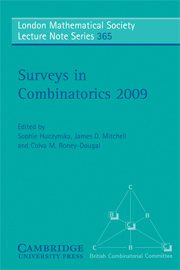Book contents
- Frontmatter
- Contents
- Preface
- 1 Graph decompositions and symmetry
- 2 Combinatorics of optimal designs
- 3 Regularity and the spectra of graphs
- 4 Trades and t-designs
- 5 Extremal graph packing problems: Ore-type versus Dirac-type
- 6 Embedding large subgraphs into dense graphs
- 7 Counting planar graphs and related families of graphs
- 8 Metrics for sparse graphs
- 9 Recent results on chromatic and flow roots of graphs and matroids
4 - Trades and t-designs
Published online by Cambridge University Press: 05 May 2013
- Frontmatter
- Contents
- Preface
- 1 Graph decompositions and symmetry
- 2 Combinatorics of optimal designs
- 3 Regularity and the spectra of graphs
- 4 Trades and t-designs
- 5 Extremal graph packing problems: Ore-type versus Dirac-type
- 6 Embedding large subgraphs into dense graphs
- 7 Counting planar graphs and related families of graphs
- 8 Metrics for sparse graphs
- 9 Recent results on chromatic and flow roots of graphs and matroids
Summary
Abstract
Trades, as combinatorial objects, possess interesting combinatorial and algebraic properties and play a considerable role in various areas of combinatorial designs. In this paper we focus on trades within the context of t-designs. A pedagogical review of the applications of trades in constructing halving t-designs is presented. We also consider (N, t)-partitionable sets as a generalization of trades. This generalized notion provides a powerful approach to the construction of large sets of t-designs. We review the main recursive constructions and theorems obtained by this approach. Finally, we discuss the linear algebraic representation of trades and present two applications.
Introduction
Let v, k, t and λ be integers such that v ≥ k ≥ t ≥ 0 and λ ≥ 1. Let X be a v-set and let Pi(X) denote the set of all i-subsets of X for any i. A t-(v, k, λ) design (briefly t-design) is a pair D =(X, B)inwhich B is a collection of elements of Pk (X) such that every A ∈ Pt(X) appears in exactly λ elements of B. Let N be a natural number greater than 1.
- Type
- Chapter
- Information
- Surveys in Combinatorics 2009 , pp. 91 - 112Publisher: Cambridge University PressPrint publication year: 2009
- 4
- Cited by



